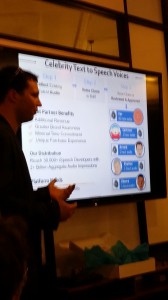Text-to-speech messaging using Obama, Bush and Schwarzenegger’s voices

Heath Ahrens, CEO and founder of iSpeech, can send you text messages using the voices of Obama, Bush and Schwarzenegger and what’s remarkable is how he makes the voices sound like, well, the real thing. And it’s free for everyone to use and play with. That’s text to speech.
“Why do people buy stickers when they can Google a photo (and just turn it into a sticker)?” asked Ahrens, the guest at the NUI (natural user interface) community meetup at WeWork Labs last April 21. It’s because the market for it is huge.
Ahrens believes “messaging app users by end of 2014 will hit 2 billion, 40 percent of these active sticker users.” Median sticker pack price estimates: $318 million.
Now, merge sticker thinking with speech-recognition and you have TalkZ, a talking sticker (png file), essentially a new UI for messaging that uses both text and voice in every message.
The use of the voices of public figures is admittedly a gray area, legally, but Ahrens also asked how public figures are just obvious choices. The audience found it entertaining to hear the voices of public figures. Ahrens has not monetized TalkZ yet.
Test it for yourself. Simply download at the Apple store (no Android or Windows version yet) and test how Obama, Bush, Schwarzenegger sounds likes in your text message to a friend, with yes, the accompanying sticker. You won’t believe your ears.
Speech recognition has certainly come a long way, although Ahrens is quick to point out that it still can’t do Shakespeare. “Statistical models can’t read Shakespeare,” he said, which in layman’s terms just mean, “it’s not natural conversation.”
Ahrens also talked about how UI in voice has remained a challenge in public. Barking commands at your phone in public is still unnatural, for one, but that’s also how Ahrens came to think of effective UIs for his products.
Before TalkZ, Ahrens started iSpeech the company back in 2007. It provides human quality text-to-speech and speech recognition solutions to consumers, developers and businesses worldwide.
The quality of text to human speech on iSpeech is so natural, even it is speaking 30 languages, doing SMS dictation or serving as a personal assistant.
Ahrens said the idea came to him back in 2007 when he wondered, “What if you could text-speech while driving, which resulted in DriveSafe.ly, a mobile messaging app aimed at curbing distracted driving.
DriveSafe.ly reads your text messages and emails it out loud, so you can concentrate on the road. It reads and automatically responds to you. And you can respond by voice.
Downloaded well over 20 million times since September of 2009, DriveSafe.ly users have reportedly heard and spoken over a billion messages.
But what is the future of messaging? If WhatsApp was acquired for $19 billion, shouldn’t there be more developments in the user experience of mobile messaging? New clever uses of multimodal technology should emerge soon.
Today, over 12,000 developers have reportedly signed up for iSpeech to power their applications, appliances, automobiles, websites and platforms.